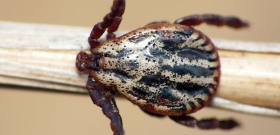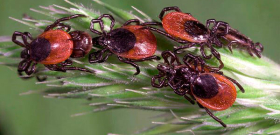
In nature, there are many different types of ticks, but most of us, when we hear the word "tick", remember exactly the parasitic arthropods - bloodsuckers and carriers of dangerous diseases. Many are interested in what these ticks eat besides blood, whether they drink water, how long they can live without food. You will find the answer to these and other questions in this article.
The mentioned ticks belong to the Ixodid family. Representatives of this family (ixodids) are found in all corners of the globe and attack humans, mammals, birds and even reptiles, drink their blood, as well as inflammatory infiltrate and tissue decay products that form at the site of the bite. Let's take a closer look at how these ticks feed.
The structure of the tick
The body of all arachnids consists of two sections - the cephalothorax and abdomen (in ticks it is the gnathosoma and idiosoma) - and four pairs of legs. Gnathosoma ixodid has a very complex structure, which contributes to the strong fixation of the parasite at the site of the bite.
On the gnathosoma there are pedipalps (leg tentacles), chelicerae (jaws) and a proboscis covered with spikes - this is the tick's oral apparatus. When bitten, the tick cuts the skin of the host with chelicerae and immerses them in the wound along with the proboscis. During feeding, almost the entire gnathosoma is located in the skin, and the tick breathes through the holes of the tracheal system, which are located on the sides of its body.
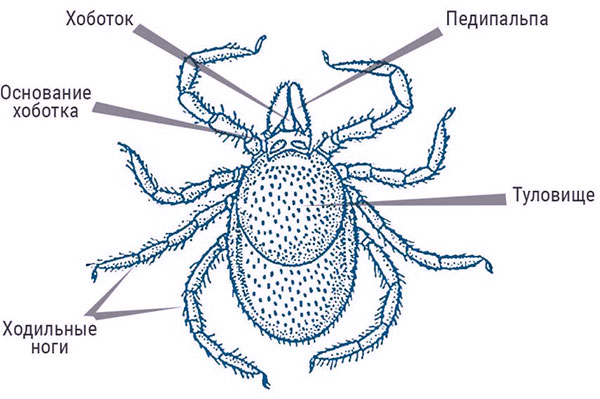
The external structure of the ixodid tick.
During the sucking of blood, the saliva of the parasite periodically enters the wound. In some species, it hardens and forms a hard "cement" case, having time to spread in the lower layers of the skin and making the base of the case wider than the top. Thus, a solid structure is obtained that does not allow the bloodsucker to be pulled out.
The mite idiosoma is covered with a dense cuticle. It has a high water resistance, thereby preventing the evaporation of excess water from the body of the arachnid. The cuticle has a large number of folds and furrows: in the process of feeding, they stretch, which allows the parasite to increase in size.
How does a parasite choose a host?
The life cycle of ixodids consists of four stages - eggs, larvae, nymphs and adults (adults) - and lasts from one and a half to three years. Each stage (except the egg) needs a single meal on the host, and depending on how many carriers the parasite replaces throughout the life cycle, mites are divided into the following types:
- Single-owner. Representatives of this type, starting from the larva, spend their whole lives on one host. The female leaves him after mating in order to lay eggs;
- Dvukhozaynye. In this type, the larva and nymph feed on one host, while the adult catches the second. Mating takes place outside the host;
- Three-host. A parasite of this type lives in nature at every stage of development and hunts for a new host. Most ixodids belong to this type.
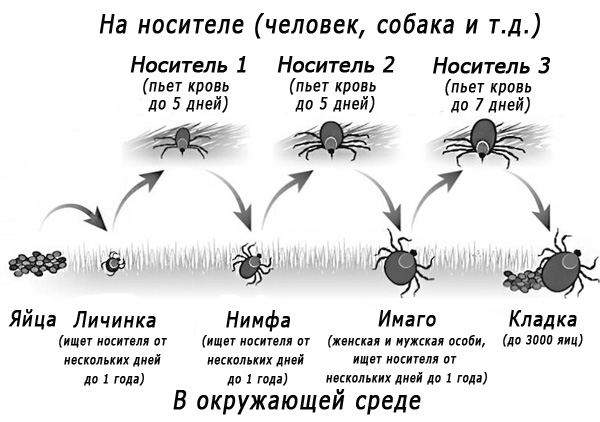
The life cycle of a tick lasts several seasons.
Tick hunting consists of passive and active lying in wait. Depending on the species and stage of development, parasites can crawl into burrows, wait for prey in fallen leaves, or climb grass and bushes.There they freeze in anticipation, stretching out the front pair of legs.
It is interesting
Ticks do not see well, and some species do not have eyes at all. Their main sense organ is the sense of smell. With the help of a special Haller's organ, located on the front legs, the parasite determines its prey by smell and carbon dioxide released. In addition, this body captures and thermal radiation.
When the tick has sensed its prey, it enters the phase of active lying in wait - it turns to the victim and makes oscillatory movements with its paws until it catches on to it.
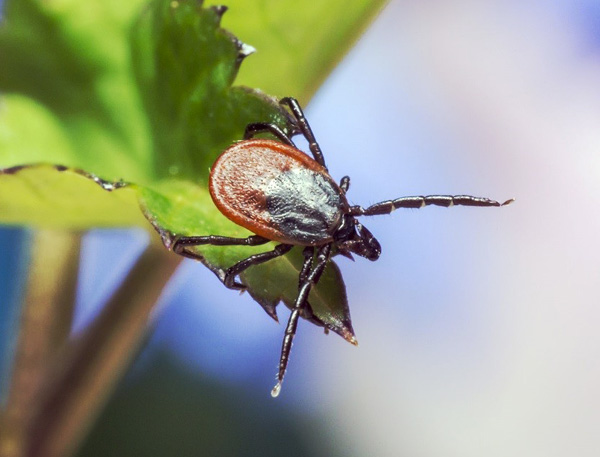
The tick put forward its paws - it is ready to attack.
On a note
If the tick senses the prey, but contact does not occur for a long time, the parasite can descend from its “post” and crawl towards it.
Ticks attack animals of different species, they do not have a strict binding to specific groups of carriers. One and the same type of single-host parasite can develop, for example, both on a rat and on a dog.
But there are also factors of the suitability of certain animals for specific types of ticks. These include the thickness of the skin, the structure of the coat and plumage, the host's ability to self-cleanse, the level of immune response to the saliva of the bloodsucker. For example, some types of ticks have special outgrowths on their paws that allow you to firmly clamp hair and wool. They are called coxal teeth and are practically not developed in species that feed on the blood of reptiles.
Bloodsucker nutrition
The bloodsucker can choose a place for a bite for several tens of minutes, traveling through the body of the victim. He is not able to bite through clothes and therefore, having got on it, he is forced to crawl over a person for a long time in search of open skin.A tick cannot bite without sucking: after all, drinking blood is the main purpose of its bite.
Ticks like to stick in secluded places: in the ears and behind them, in the armpits, groin, on the neck and head, in the folds of the limbs and skin folds. There, the skin is thinner and it is easier to get to the blood vessels. The parasite can drink human blood for quite a long time - sometimes more than 10 days.
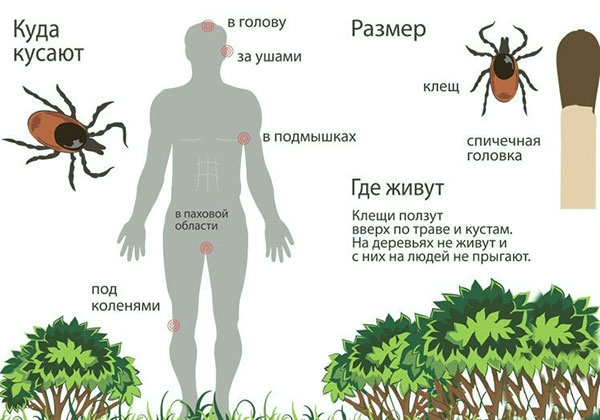
The tick looks for places on the body where it is easier to get to the blood vessels.
The process of sucking blood is not constant. During the entire period, while the parasite is attached to the victim, several phases of feeding and dormancy are replaced. The act of sucking is a series of rhythmic expansions and contractions of the pharynx, drawing blood into the esophagus. This is followed by a phase of salivation into the preoral cavity, followed by a resting stage, during which neither blood absorption nor salivation occurs.
In three-host species of ticks, the larvae feed for 2-4 days, then fall off and, after molting, turn into nymphs. The last one needs a week to feed. Adult females need a substantial supply of protein in order to lay eggs, and the duration of the feeding process can be up to 10 days, and males drink blood very quickly: they only need a few hours, and sometimes even less.
It happens that the male attacks the engorged fellow and sucks blood from him, while the victim tick is not severely damaged, and the female, after an experienced attack, can lay eggs without any problems.
In the process of feeding, the size and mass of blood-sucking arachnids increase many times over.In the most common dog and taiga ticks in Russia, the body weight of an individual full of blood increases by 80-100 times compared to the weight of a hungry tick. The body of the parasite swells and becomes like a grape.
A bloodshot mite is shown in the following photo:
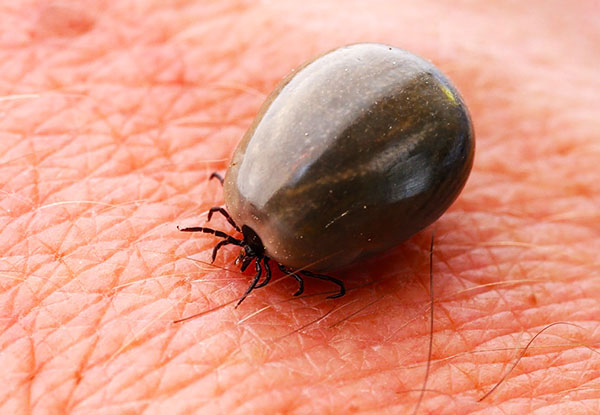
The parasite usually drinks a much larger mass of blood than the already dead tick weighs, since digestion and defecation processes occur in the process of feeding. For one feeding, the parasite can drink up to 8 g of blood, while the mass of a sucked tick is about 1 g, and a hungry one - 7-10 mg.
After the female completes feeding, eggs ripen in her ovary. This process can take from a week to a month. The process of laying eggs is also not fast and lasts about a month.
Usually laying eggs are located in the crevices of the soil, but it happens that the female lays her eggs directly on the skin of the victim.
The type of tick hunting requires a long wait and, accordingly, the same long fasting. Ixodids may not eat until 8-10 months, but a tick brought into an apartment on clothes will not last even a couple of days - a person’s home usually does not have the humidity he needs.
Do these arachnids need water?
To maintain vital activity, in addition to blood, ticks need water. They prefer warm moist places and avoid dry areas of the habitat. When the victim waits for a long time at the tip of a blade of grass or a branch of a bush, the parasite loses moisture, and it needs to replenish it. The main loss of water by a bloodsucker occurs by evaporating it through the cuticle covering the body, and through the tracheal system, as well as with waste products that are excreted from the body.
Only a small number of ixodid species drink water in our usual sense. Most mites, on the other hand, absorb water vapor from moisture-saturated air, for which they descend from their hunting post to the ground and crawl into cracks in the soil or fallen leaves.
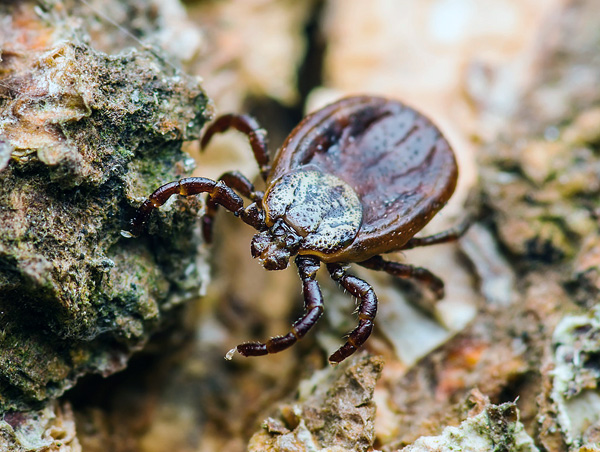
To replenish moisture, mites crawl under fallen leaves or into cracks in the soil.
Absorption of water vapor occurs in the preoral cavity of the arachnid, where hygroscopic saliva is secreted. It is she who absorbs water vapor from the air, and then is swallowed by a tick.
borne infections
Tick saliva can contain viruses and bacteria that cause dangerous diseases. The most famous of these are tick-borne encephalitis and Lyme disease (tick-borne borreliosis). These diseases are severe and can lead to disability and even death. For dogs, tick-borne piroplasmosis is often fatal, so a pet bitten by a bloodsucker and suddenly ill pet must be urgently shown to the veterinarian.
A tick cannot infect a person or animal without sucking, but simply crawling over the body. For infection, it is necessary to get his saliva into the blood of the victim. Infection is also possible if the contents of the parasite crushed on the skin get into a wound or scratch that happens to be nearby.
On a note
The bite of the tick is not noticeable: the victim does not feel pain due to the fact that the saliva of the tick contains anesthetic substances. Therefore, most often already pumped and swollen individuals are found on the body.

A person does not feel the moment of biting the skin with a tick, since the saliva of the parasite contains an anesthetic. In the figure, purple shows a cement case made of hardened saliva.
Another way of infection with tick-borne encephalitis is milk from a goat or cow bitten by an infected tick, which has not undergone heat treatment.
What do other ticks eat?
The world of ticks is very diverse, these arachnids live everywhere, and almost everything is suitable for them to eat. There are armies of saprophagous ticks that feed on rotting leaves and help soil formation. There are mites that feed on plant juices, the most famous among them are spider mites and gall mites. There are mycophagus mites - they eat mushrooms. There are predators that prey on other ticks and small insects.
Parasitic mites are divided into temporary and permanent parasites. Temporary parasites live in the natural environment, prey on the host and disappear after sucking blood. These include ixodid and argas ticks. Argasids, like ixodids, feed on blood, but do not passively wait for prey, but actively seek prey. In addition, they are characterized by omovampirism - a phenomenon when a hungry arachnid sticks to a satiated fellow.
Permanent parasites spend their entire lives on the host. These mites parasitize all groups of animals and humans. They settle in hair follicles, in the skin, in the ears, respiratory tract, feather feathers, insect tracheas.
Among them, it is worth noting the scabies itch, which gnaws through the passages inside the skin and causes such an unpleasant disease as scabies.
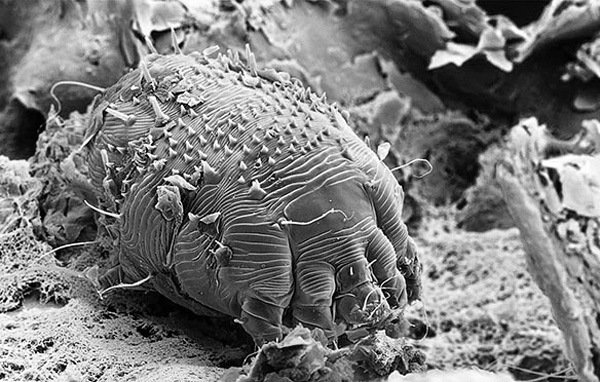
This is what a scabies mite looks like under a microscope.
In the hair follicles of almost all people, the acne gland lives, feeding on the secretions of the sebaceous glands. Usually it is harmless, but with reduced human immunity, it can cause demodicosis.
Dust mites live in houses, feeding on dead skin flakes.By themselves, they are not dangerous, but their secretions often cause allergies and asthma.
Myths about ticks
Finally, let's look at the popular myths about the taste preferences of ixodid ticks:
- Ticks do not bite everyone, but they love a certain blood type - in fact, scientists have not identified any pattern between the frequency of bites and a person's blood type;
- Ticks don't bite drunk people. This myth is just an attempt to justify a bad habit. Alcohol in the blood does not affect the parasite in any way, and in an intoxicated state, you may not notice a sucking tick;
- Only female ticks bite - both sexes suck blood, however, females feed for several days, making reserves for the formation of eggs, and sometimes half an hour is enough for males. In rare species, adult males do not really eat, their role is reduced only to fertilization;
- Men get bitten more often - this myth is due to the fact that men just go to the forest more often.
Features of the life cycle and structure of ixodid ticks are maximally aimed at providing blood supply and resettlement over vast territories. The change of hosts contributes to the spread of ticks, and a huge number of eggs and larvae ensures the survival of the population. The structure of the oral apparatus makes it possible to firmly fix on the host animal, and the elastic cuticle allows it to accommodate a large amount of blood and provide a supply of nutrients to the sucking parasite for a long time.
Thus, ixodids are successfully adapted to a parasitic way of life and, in addition to blood and water, they do not need other sources of food.
Useful video: how and what the tick eats


